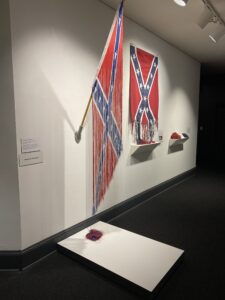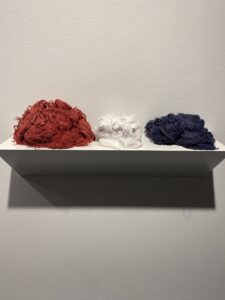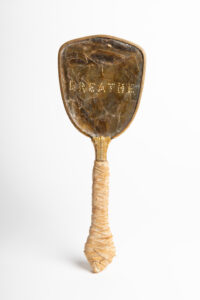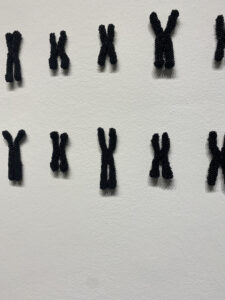Sonya Clark: Tatter, Bristle, and Mend
Curated by: Kathryn Wat and Hannah Shambroom
Exhibition Schedule: National Museum of Women in the Arts, March 3–June 27, 2021
Exhibition Catalog: Elizabeth Lynch, Sonya Clark: Tatter, Bristle, and Mend, ex. cat. Washington, DC: National Museum of Women in the Arts, 2021. 176 pp.; 97 color illus. Paper: $32.95 (ISBN: 9780940979543)
Sonya Clark (b. 1967)—an American artist of Afro-Caribbean descent—is best known for her use of mixed media, often sourced from material culture (think: human hair, combs, pencils, mirrors, books, flags, paper money) and always with a reference to race, culture, and history. An emphasis on the handmade is ever present, a legacy of influence that Clark attributes to her maternal grandmother (a professional tailor) and to the stories that these objects may tell. The resulting artworks move between two and three dimensions and offer up historical, cultural, and intellectual critiques rooted in materiality.
With more than one hundred works on view, Sonya Clark: Tatter, Bristle, and Mend is the first (and long overdue) midcareer survey of the artist and the last exhibition mounted at the National Museum of Women in the Arts before it closed for renovation. As with many other exhibitions that opened during the pandemic, Tatter, Bristle, and Mend had both physical and virtual components. For those unable to visit the museum in person, the NMWA’s website (https://nmwa.org/exhibitions/sonya-clark-tatter-bristle-and-mend) includes a robust audio guide featuring interviews with Clark as well as a virtual exhibition.

The exhibition is organized in four rooms and around central themes focusing on heritage, labor, language, and visibility. It includes some of the artist’s early works with beading and stitching as well as more recent engagements with materials like neon. On full display is Clark’s mastery of various media and techniques—from weaving to photography, knotting, beading, and stitching. It is a dazzling array of works by an artist with a deep knowledge of her materials. We see, for example, a consistent engagement with hair that ranges from the political to the absurd—from the poignant winding of dreadlocked human hair into Skein (2016), to the experimental replacement of horsehair with human hair on a violin bow in Hairbows (2014), to the inclusion of hair on a five-dollar bill in Afro Abe II (2010). We find this actual hair in addition to thread that Clark has woven into various styles (e.g., the Wig series of 1998) or haunting forms (e.g., Triangle Trade, 2011). The combs that greet us at the entrance to the exhibition (Curls, 2005) continually reappear in later works, including a larger-than-life portrait using more than three thousand combs in Madam C. J. Walker (2008). In another example, Toothless (2014), the plastic combs are arranged in a tapestry, gradually losing their teeth as the arrangement descends ever closer to the floor below.
It is a difficult (and perhaps fruitless) task to summarize Clark’s complex engagements with these materials in an exhibition that resists the classic chronological organization of most retrospectives. Some rooms are organized according to their subject (e.g., the flag room), while other arrangements coalesce around a shared material (e.g., beads or combs). The overall impression, however, is not one of disorganization but an invitation to contemplate the implicit connections and concerns that characterize Clark’s vast oeuvre. This invitation is carried over to individual works, especially those that lack explanatory labels. What results is an emphasis on the formal and aesthetic powers of Clark’s practice and on what can be gained by thinking out of sequence.

In one room we find a dimly lit installation of Clark’s flags, which the artist has variably woven, dyed, bleached, and unraveled. Each example has been installed under a spotlight that casts an aura or glow onto the individual object. The curator’s choice to collect these examples of Clark’s engagement with the flag in a single space allows the viewer to observe the artist’s continuous engagement with this symbol as well as her increasing dexterity with the cloth. While we are not able to witness the live performance and unraveling of these flags—as would often be the case for an exhibition of Clark’s works—the groupings in this room highlight the process of disassembling and manipulating the cloth of the Confederate flag. For example, the works Unraveled Persistence (2016), Unraveling (2015), and Unraveled (2015) exist as a kind of triptych, revealing the stages of Clark’s process (fig. 1). Their arrangement invites us to imagine the slow and delicate procedure of disentangling the tightly bound warp and weft. Perhaps we are even surprised to see the once-taut cloth of the Confederate flag, which itself hides the threads of its making, disassembled into three balls of cotton thread—red, white, and blue—stacked on the shelf (fig. 2). As Clark has explained in interviews, the revelation of just how tightly woven these fabrics are and the painstaking effort required to undo them is, in part, an analog for the structure of white supremacy that lies beneath every facet of life in America.
Attention to Clark’s artistic evolution and process is apparent in every room of the exhibition. It is no surprise that her mastery of multiple materials and media is on full display. Cotton (in both its raw and processed forms), hair, and beads are the most frequently used materials, and as we encounter the artist’s manipulations of these elements in the gallery space, we are encouraged to think through their social dimensions. For example, a wall label for the photograph Mom’s Wisdom or Cotton Candy (2011) draws a range of connections based on the material, from the personal (the whitened hair of Clark’s own mother) to the historical (the paramount role of sugar in the early trade of enslaved people).
Clark’s explicit emphasis on forms of handwork—beading, embroidery, weaving—brings her objects into closer critical alignment with questions of gendered labor and experience. Clark is herself entangled within the labor of making rather than observing or collecting these materials from a distance. Works like Mom’s Wisdom, alongside Clark’s oft-mentioned childhood experiences watching the women in her community sewing, weaving, and braiding, place these works within a feminist and even an epistemological framework. Watching one’s mother or grandmother is an act of knowledge production for many women, including Clark. Such actions lead to questions about how we know what it means to be a woman or how we know Blackness.

Language (and writing) is another constant theme throughout the exhibition. Entering into a smaller, darkened alcove off the main room, one encounters a vitrine holding three objects. On the left sits the work Being Invisible and Without Substance (2018), in which Clark has altered a copy of Ralph Ellison’s novel Invisible Man by piercing it with pinholes, and on the far right is Black Man (Invisible) (2016), in which Clark has fully encased Ellison’s text in beading. At the center sits the slightly abject and wholly tactile Writer Type (Pen and Sword) (2016), consisting of a vintage typewriter of the sort produced at the height of the Harlem Renaissance, with tufts of hair instead of keys. Along the same wall are displayed two pencils with hair in place of their erasers (Erasure, 2015). Five of these works, along with the digital print Long Hair Book (2005) and the modified hand mirror titled BREATHE (1994; fig. 3), provide an overview of Clark’s engagement with literature and language. In the latter example, Clark has inscribed the word “breathe” with pinholes punched into the surface of a found hand mirror; the artist replaced the original mirror with a cut-and-fitted piece of mica and wrapped (or, perhaps we can say, bandaged) the handle in a thin strip of cloth. Where we might expect to see our own reflection, we are met instead with an instruction that points us to the physical body rather than to its perception, with an invitation to question the relationship between the reality of Black life—recalling the police killings of George Floyd, Eric Garner, and many others before them—and its image.
The ontological character of Clark’s practice is perhaps the most surprising result of seeing this exhibition in person. In every room of the exhibition, we find clear (and clever) engagements with the conceptual nature of being. In several works, Clark focuses on genetic coding and its expression in the body—this time using beads as her primary medium. Chromosomes (2004; fig. 4) consists of forty-six small beaded sculptures, which have been installed in two rows along one wall. The arrangement refers to the diploid number of chromosomes in humans—that is, twenty-three pairs of chromosomes in each human cell. But, looking closely, we notice that the last chromosomes are XY, meaning the biological assignment of male, perhaps calling our attention to the ambivalence of gender assignment, the gap between biology and reality. For the 2002 work Melanin, Clark arranged beads of multiple colors in a genetic sequence to represent melanin (the pigment that gives color to the skin, eyes, and hair). Here again we are encouraged to think about the relationship between genetic and societal differences. Overall, these works center on the question: What is Blackness?

The exhibition is accompanied by a catalogue that includes an interview with Clark by prominent historian and visual artist Nell Painter, a poem by Nikky Finney, three critical essays focused on major themes in Clark’s oeuvre (two on hair, by Bridget R. Cooks and Salahmishah Tillet, and one on the flag by historian Tita Miles), as well as a curatorial essay by Kathryn Was and Hannah Shambroom. The texts make up a third of the catalogue, with its remainder consisting of full-page color illustrations of featured works in the show. Taken together, the written texts offer multiple points of entry into Clark’s work, and it is satisfying to see the range of disciplinary perspectives and experiences that carry throughout—from personal histories, to legislative acts, to historical perspectives. In the essay “Tethered,” Cooks, for example, explores Clark’s use of hair as “object, symbol, and currency for organizing the world . . . as a metonym for Blackness” and its place within American national identity. In “Truth and Reconciliation: The Political Work of Sonya Clark’s Confederate Flag of Truce,” Miles dives into the material and political history of this object, as well as its affective potential when placed in a performative context (as in Clark’s 2019 participatory installation Reconstruction Experience at the Fabric Workshop and Museum in Philadelphia). Was and Shambroom’s essay, which appears as the final essay in the volume and bears the title of the exhibition itself, “Tatter, Bristle, Mend,” offers a useful overview of the most prescient themes and materials in Clark’s practice—the use of hair as textile, plastic barber combs, the acts of unraveling and triangulation, and beadwork. Each essay is a provocation, an invitation to engage with Clark’s work.
Too often the analysis of works by Black artists is limited to the social or political subjects that are most easily identifiable in their creations. We overlook the deeper ontological or epistemological questions that lie within, preferring instead to read these artists as political spokespersons for issues of race, gender, or whatever other identity they are assigned. This limited interpretation has meant, as we know, that artists of color working in abstraction from the mid-twentieth century through to the present day have been overlooked in favor of those creating more overtly narrative or figurative works. An additional consequence has been that many artists (like Clark), who move between formal, narrative, and conceptual concerns, have been simply passed off as social commentators. Tatter, Bristle, and Mend shows us the necessity of thinking otherwise.
Cite this article: Jordana Moore Saggese, review of Sonya Clark: Tatter, Bristle, and Mend, National Museum of Women in the Arts, Panorama: Journal of the Association of Historians of American Art 7, no. 2 (Fall 2021), https://doi.org/10.24926/24716839.12796.
PDF: Saggese, review of Sonya Clark
About the Author(s): Jordana Moore Saggese is Associate Professor of American Art at University of Maryland, College Park

